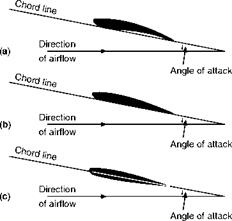Chord line and angle of attack
It has already been mentioned that the angle of inclination to the airflow is of great importance. On a curved aerofoil it is not particularly easy to define this angle, since we must first decide on some straight line in the aerofoil section from which we can ensure the angle to the direction of the airflow. Unfortunately, owing to the large variety of shapes used as aerofoil sections it is not easy to define this chord line to suit all aerofoils. Nearly all modern aerofoils have a convex under-surface; and the chord must be specially defined, although it is usually taken as the line joining the leading edge to the trailing edge. This is the centre in the particular case of symmetrical aerofoils.
We call the angle between the chord of the aerofoil and the direction of the airflow the angle of attack (Fig. 3.5).
This angle is often known as the angle of incidence; that term was avoided in early editions of this book because it was apt to be confused with the riggers’ angle of incidence, i. e. the angle between the chord of the aerofoil and some fixed datum line in the aeroplane. Now that aircraft are no longer ‘rigged’ (in the old sense) there is no objection to the term angle of incidence; but by the same token there is no objection either to angle of attack – many pilots and others have become accustomed to it; it is almost universally used in America, and so we shall continue to use it in this edition.
[Note. If we wish to be precise we must be careful in the definition of the term ‘angle of attack’, because, as has already been noticed, the direction of the airflow is changed by the presence of the aerofoil itself, so that the direction of the airflow which actually passes over the surface of the aerofoil is not the same as that of the airflow at a considerable distance from the aerofoil. We shall consider the direction of the airflow to be that of the air stream at such a distance that it is undisturbed by the presence of the aerofoil.]
|
Fig. 3.5 Chord line and angle of attack (a) Aerofoil with concave undersurface. (b) Aerofoil with flat undersurface. (c) Aerofoil with convex undersurface. |












